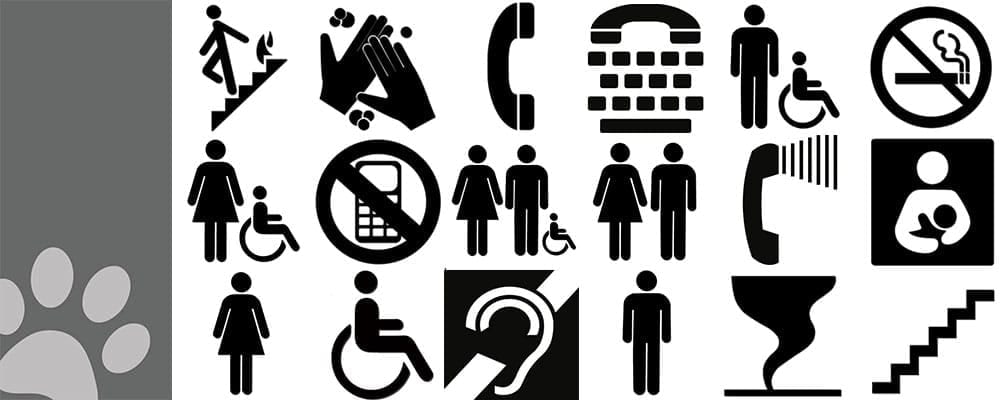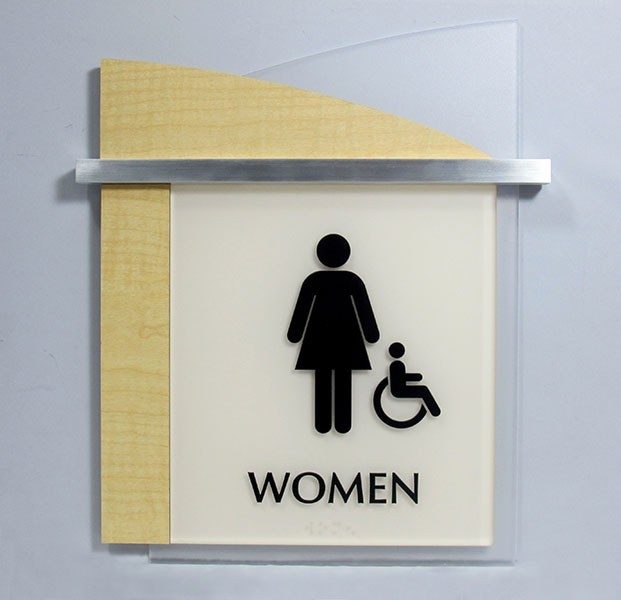Just How ADA Signs Improve Ease Of Access for Everyone
Just How ADA Signs Improve Ease Of Access for Everyone
Blog Article
Checking Out the Secret Features of ADA Signs for Enhanced Ease Of Access
In the world of availability, ADA signs serve as quiet yet powerful allies, ensuring that spaces are comprehensive and navigable for individuals with handicaps. By incorporating Braille and responsive components, these indications break barriers for the aesthetically impaired, while high-contrast shade systems and clear font styles cater to diverse visual requirements.
Significance of ADA Conformity
Making sure conformity with the Americans with Disabilities Act (ADA) is critical for cultivating inclusivity and equal accessibility in public rooms and work environments. The ADA, enacted in 1990, mandates that all public centers, companies, and transportation services accommodate people with specials needs, ensuring they appreciate the very same rights and opportunities as others. Compliance with ADA standards not just fulfills lawful responsibilities however also improves a company's track record by demonstrating its dedication to variety and inclusivity.
Among the essential aspects of ADA conformity is the execution of obtainable signage. ADA signs are made to ensure that people with specials needs can easily navigate through rooms and structures. These indications should stick to certain standards relating to dimension, font style, color comparison, and positioning to ensure visibility and readability for all. Appropriately executed ADA signs assists remove obstacles that people with disabilities frequently encounter, therefore advertising their self-reliance and self-confidence (ADA Signs).
Additionally, adhering to ADA policies can mitigate the risk of prospective fines and lawful effects. Organizations that fall short to conform with ADA guidelines might encounter penalties or lawsuits, which can be both financially difficult and harmful to their public image. Hence, ADA conformity is indispensable to cultivating a fair environment for everybody.
Braille and Tactile Elements
The consolidation of Braille and tactile elements right into ADA signs symbolizes the principles of accessibility and inclusivity. These features are important for individuals that are aesthetically damaged or blind, allowing them to browse public rooms with higher freedom and confidence. Braille, a tactile writing system, is necessary in providing composed info in a format that can be easily regarded with touch. It is generally placed beneath the matching text on signage to ensure that individuals can access the details without aesthetic assistance.
Tactile aspects prolong past Braille and include increased signs and personalities. These components are made to be discernible by touch, enabling people to identify room numbers, bathrooms, departures, and various other critical locations. The ADA establishes particular guidelines relating to the dimension, spacing, and positioning of these responsive aspects to enhance readability and ensure consistency across various environments.

High-Contrast Color Pattern
High-contrast color design play a pivotal duty in enhancing the visibility and readability of ADA signs for people with visual impairments. These systems are crucial as they make the most of the difference in light reflectance between message and background, making certain that indicators are conveniently noticeable, also from a range. The Americans with Disabilities Act (ADA) mandates making use of details color contrasts to accommodate those with minimal vision, making it a critical facet of conformity.
The effectiveness of high-contrast shades lies in their ability to stand out in numerous illumination conditions, including dimly lit settings and locations with glare. Typically, dark message on a light background or light text on a dark background is employed to attain ideal contrast. Black message on a yellow or white background supplies a stark visual difference that aids in quick acknowledgment and understanding.

Legible Fonts and Text Size
When taking into consideration the layout of ADA signage, the selection of clear fonts and proper text size can not be overemphasized. These components are essential for guaranteeing that indications come to individuals with visual problems. The Americans with Disabilities Act (ADA) mandates that font styles have to be Recommended Reading not italic and their explanation sans-serif, oblique, script, very decorative, or of unusual kind. These demands help guarantee that the message is quickly legible from a range and that the characters are distinct to diverse target markets.
The size of the text additionally plays a critical role in accessibility. According to ADA standards, the minimum message height should be 5/8 inch, and it ought to raise proportionally with checking out distance. This is particularly crucial in public areas where signage needs to be checked out rapidly and precisely. Consistency in text dimension adds to a natural visual experience, helping people in browsing atmospheres efficiently.
Additionally, spacing between lines and letters is important to legibility. Appropriate spacing stops personalities from appearing crowded, enhancing readability. By adhering to these criteria, designers can dramatically enhance access, making certain that signage offers its designated purpose for all people, despite their aesthetic capacities.
Efficient Positioning Methods
Strategic positioning of ADA signage is crucial for optimizing availability and ensuring conformity with lawful criteria. ADA guidelines stipulate that indications must be mounted at an elevation between 48 to 60 inches from the ground to guarantee they are within the line of sight for both standing and seated people.
In addition, indicators have to be positioned adjacent to the latch side of doors try here to enable simple recognition before entry. This positioning assists individuals situate areas and areas without blockage. In instances where there is no door, indicators ought to be located on the local adjacent wall surface. Consistency in sign placement throughout a facility enhances predictability, minimizing complication and boosting total customer experience.

Verdict
ADA indicators play a crucial function in advertising ease of access by integrating functions that attend to the requirements of people with specials needs. Integrating Braille and responsive elements makes sure vital info comes to the aesthetically damaged, while high-contrast color pattern and readable sans-serif fonts improve exposure across various illumination problems. Reliable positioning strategies, such as suitable mounting elevations and tactical areas, even more facilitate navigating. These aspects jointly promote a comprehensive setting, emphasizing the importance of ADA conformity in making sure equivalent access for all.
In the realm of ease of access, ADA signs serve as quiet yet effective allies, guaranteeing that areas are navigable and comprehensive for people with handicaps. The ADA, established in 1990, mandates that all public facilities, employers, and transportation services accommodate people with disabilities, guaranteeing they take pleasure in the same civil liberties and opportunities as others. ADA Signs. ADA indications are designed to make sure that people with disabilities can easily navigate through buildings and rooms. ADA guidelines specify that indicators should be installed at an elevation in between 48 to 60 inches from the ground to guarantee they are within the line of sight for both standing and seated people.ADA indicators play an essential role in promoting access by integrating features that attend to the needs of individuals with impairments
Report this page